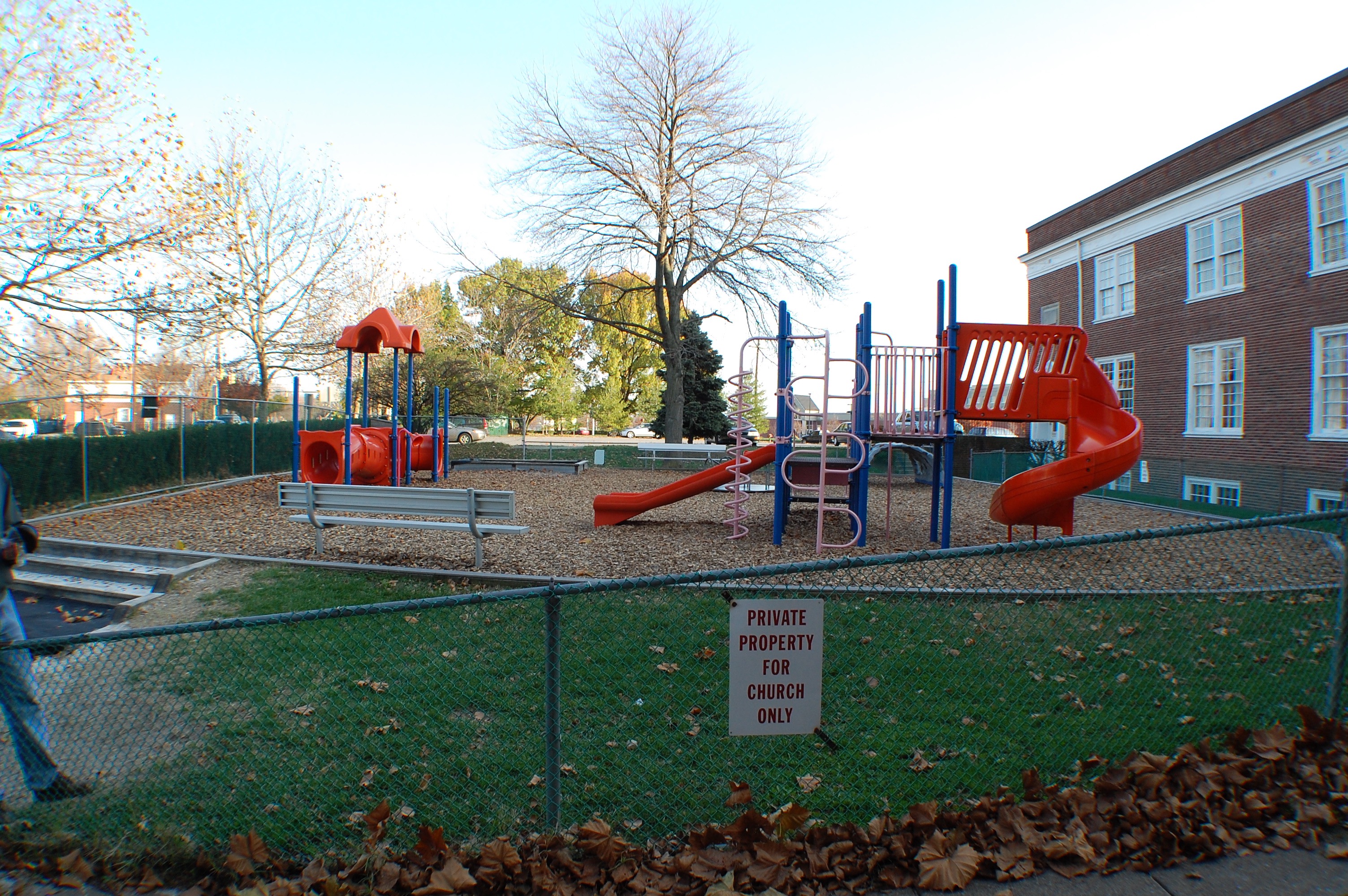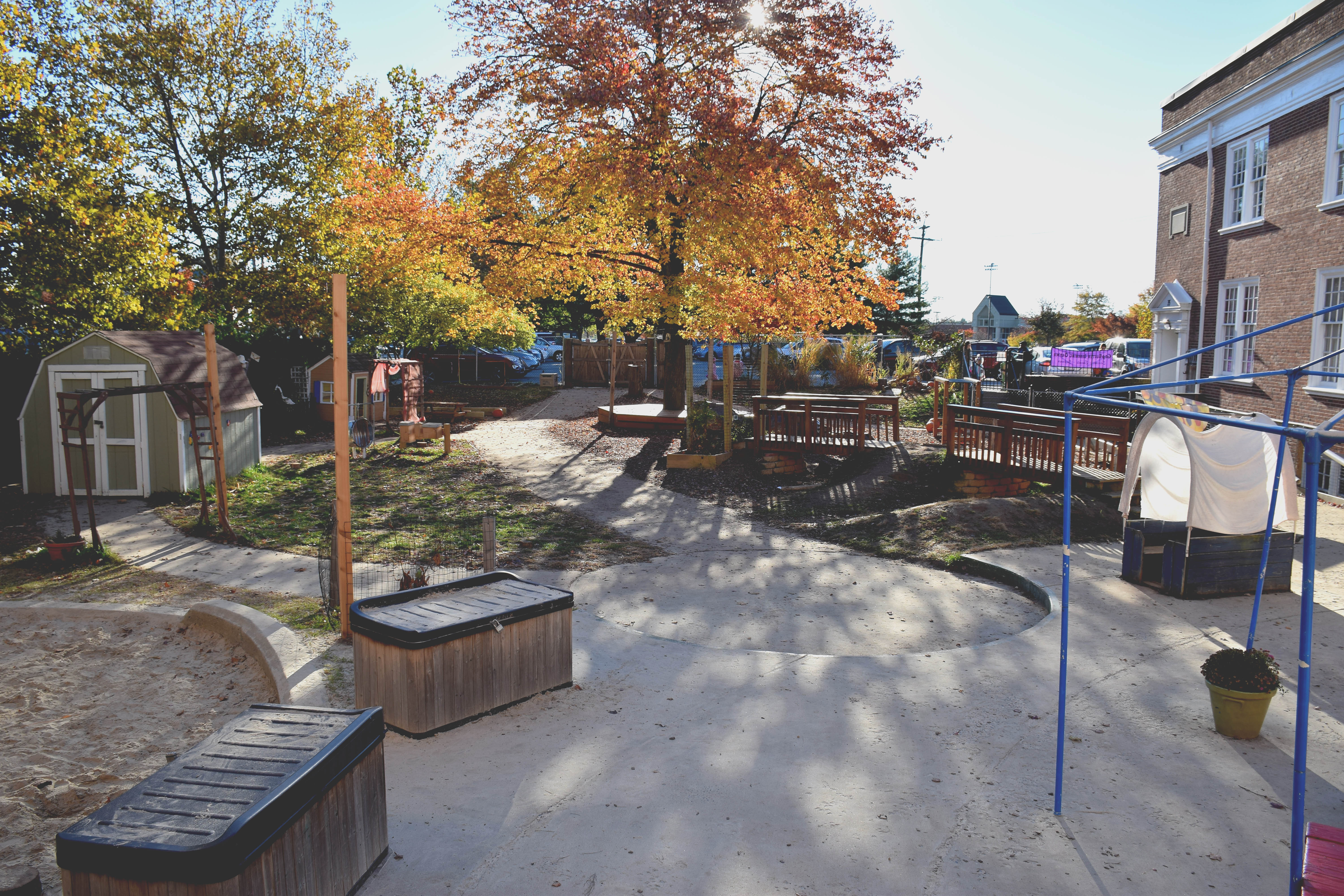One of the most unique and busy spaces of Silver Spring Day School is its playground. Whether it’s visiting with parents after school, running around with children during a co-op shift, or hanging around the fence to spy on the Pre-Kers after drop-off, SSDS families spend a lot of time on the playground. It’s probably also true that most families remember the first time they visited it: Where are the swings, the play structure? What are all these logs doing everywhere? And, what is that? Is that a dragon?
The SSDS playground’s history is not well known, though it was among the first nature-based playgrounds in Montgomery County. More, perhaps, than any other space at the school, the playground exemplifies core components of the SSDS ethos: community and life-long learning.

It took many hands to make the SSDS playground, including local business Foulger Pratt (top left, building the SSDS monkey bars), SSDS students themselves (top right, making cement imprints with leaves) and Eagle scout troop 1441 (bottom, constructing the pond) and TW Perry, which donated the materials for the stage (not pictured).
The playground’s story begins at one of SSDS’s previous locations—Colesville Presbyterian Church—familiar to us as the location of the Ice Cream Social and Octoberfest. When the school was housed there, SSDS Executive Director Richelle Meer reports, teachers and staff observed how the students interacted with the outdoor space. The children didn’t pay much attention to the play structure or spend time on the swings. Instead, they climbed the trees, scaled a large mulch pile, used rocks and logs to redirect water running down the bank to the parking lot. In that wide open space, the kids used their imaginations and engaged with the natural world around them.
When the current SSDS location was identified, Richelle, along with other teachers and staff, began to ask, “How can we recreate this experience at one of the busiest intersections in Montgomery County?” And that’s where the real story begins.
Inspired by the children’s interaction with the natural space at the old location, teachers and staff began researching, continuing on their own path of life-long learning. Early on, they came across the book, Last Child in the Woods, a national bestseller by Richard Louv. The book emphasizes the importance of nature for child development, and notes that playtime —especially the unstructured, exploratory type of play that is possible in a natural setting —“is increasingly recognized as an essential component of wholesome child development.” Natural settings “stimulate all the senses and integrate informal play with formal learning.” Louv cites a series of studies that “compared preschool children who played every day on typically flat playgrounds to children who played for the same amount of time among the trees, rocks, and uneven ground of natural play areas. Over a year’s time, the children who played in natural areas tested better for motor fitness, especially in balance and agility.”

Kids, parents, and teachers use the playground in many different ways, all day long.
But nature-based playgrounds do more than enhance physical development. They encourage creativity and help children form a life-long connection with the natural world, a connection that Louv notes is important for developing the next generation of environmentalists and conservationists.
As for the play-based learning that is a fundamental component of the SSDS curriculum, the so-called “loose-parts” available in a nature-based space (such as all those logs) allow for open-ended, imaginative play. The inventiveness of the play, it turns out, is directly proportional to the number and types of materials in the environment. A slide is for sliding. A dragon tail is for, well, you name it.
Bringing the vision to life required more than research, however. It required materials, construction savvy, muscle, and many, many hours of labor. And that’s where the SSDS community comes in. The playground in its current form was built by teachers, staff, parents, community members, and, importantly, the children of SSDS.

In 2010, before the SSDS playground renovations.
From the beginning, 4s teacher Ms. Veronica was integrally involved in bringing the vision to life. “I’m a builder in my own way,” she said, and the playground “is my baby.” When SSDS prepared to move to its current location, Ms. Veronica continued her own education, attending a series of seminars on the rules and regulations of playgrounds organized by the National Association for the Education of Young Children (NAEYC). And since then she has taken responsibility for much of the development of the space.
What is so wonderful about Ms. Veronica’s conceptions for the playground is that she opens them up to the children, mainly through Little University and summer camp sessions. Not only does she involve the children in the design and planning stages, she involves them in the building.
Among the features attributable to Ms. Veronica and her little helpers are: the herb garden along the steps, the “fort” to the right of the parking lot gate, the drums, the raised bed garden by the climbing tree, (no, never mind, better make that a digging pit!), the taller raised bed garden along the back fence, and the climbing plants by the berms.

The finished SSDS playground.
Parents have also made huge contributions to the development of the playground and have helped harness the broader community to the effort. SSDS father Nick Homer is a noteworthy example. One-time head of the playground committee, Nick says he enjoyed looking for inexpensive ways to make the playground more fun. Never a fan of flat grassy or mulch areas, he began thinking about possibilities to add altitude and tunnels, or a jumping element. Nick began researching and uncovered an early plan for the playground and some construction drawings from a landscape firm specializing in nature-based playgrounds.
First, he helped to organize a donation from TW Perry and built the stage around the tree. Then, when putting an addition on his home, he had the dirt that was dug up for the foundation and the lumber from his disassembled deck delivered to SSDS. They became the berms and the bridges — important “loose-parts” for the kids to sit in, on, and under.
It is impossible to re-tell the entire history of the nature-based playground in one blog post, or acknowledge the hard work and endless time that so many staff, students, parents and community members put into developing it. Deserving of mention, however, are: SSDS parent Max Fox, who conceived of and built the climbing wall; SSDS art teacher Ms. Carol, who, along with students, built or painted much of the art, such as the wheel sculpture above the sandbox and the mosaic sun; Eagle Scout Troop 1441, led by SSDS graduate Felix Vargish, who built the pond; and Home Depot (Cherry Hill), Foulger-Pratt, Montgomery County and North Face who donated money, materials, plants, and/or time to make the playground what it is.
SSDS strives to teach our children that learning is fun, active and driven by the learner. It also emphasizes that ethos to its parents, teachers, and community members. The playground is living proof that members of a community, no matter their background, profession, or age, can unite shared curiosity and drive to beautiful ends.
By Korin Davis (mom to Faye, Ms. Judy’s 3’s and Amos, SSDS ’14)

